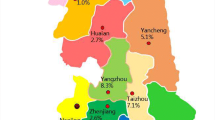Abstract
We examined the quinolone resistance–determining region (QRDR) of gyrA, gyrB, and parC of recently isolated fluoroquinolone-resistant S. dysenteriae type 1 strains from south Asia and compared data with fluoroquinolone-susceptible strains associated with previous epidemics of 1978, 1984, and 1994. In fluoroquinolone-resistant strains, double mutations (Ser83 → Leu, Asp87 → Asn or Gly) and a single mutation (Ser80 → Ile) were detected in the QRDRs of gyrA and parC, respectively.
Similar content being viewed by others
Literature Cited
Altschul SF, Gish W, Miller W, Myers EW, Lipman DJ (1990) Basic local alignment search tool. J Mol Biol 215:403–410
Ding J, Ma Y, Gong Z, Chen Y (1999) A study on the mechanism of the resistance of Shigellae to fluoroquinolones. Zhonghua Nei Ke Za Zhi 38:550–553
Dutta S, Kawamura Y, Ezaki T, Nair GB, Iida K, Yoshida S (2005) Alteration in the gyrA subunit of DNA gyrase and the parC subunit of topoisomerase IV in quinolone-resistant Shigella dysenteriae serotype 1 clinical isolates from Kolkata, India. Antimicrob Agents Chemother 49:1660–1661
Everett MJ, Jin YF, Ricci V, Piddock LJ (1996) Contributions of individual mechanisms to fluoroquinolone resistance in 36 Escherichia coli strains isolated from humans and animals. Antimicrob Agents Chemother 40:2380–2386
Ghosh AS, Ahamed J, Chauhan KK, Kundu M (1998) Involvement of an efflux system in high-level fluoroquinolone resistance of Shigella dysenteriae. Biochem Biophys Res Commun 242:54–56
Hata M, Suzuki M, Matsumoto M, Takahashi M, Sato K, Ibe S, et al. (2005) Cloning of a novel gene for quinolone resistance from a transferable plasmid in Shigella flexneri 2b. Antimicrob Agents Chemother 49:801–803
Jacoby GA, Chow N, Waites KB (2003) Prevalence of plasmid-mediated quinolone resistance. Antimicrob Agents Chemother 47:559–562
Jonas D, Biehler K, Hartung D, Spitzmuller B, Daschner FD (2005) Plasmid-mediated quinolone resistance in isolates obtained in German intensive care units. Antimicrob Agents Chemother 49:773–775
Komp Lindgren P, Karlsson A, Hughes D (2003) Mutation rate and evolution of fluoroquinolone resistance in Escherichia coli isolates from patients with urinary tract infections. Antimicrob Agents Chemother 10:3222–3232
Naheed A, Kalluri P, Talukder KA, Faruque AS, Khatun F, Nair GB, et al. (2004) Fluoroquinolone-resistant Shigella dysenteriae type 1 in northeastern Bangladesh. Lancet Infect Dis 10:607–608
National Committee for Clinical Laboratory Standards (2004) Performance standards for antimicrobial susceptibility testing; approved standard, 14th ed; document M100-S14. Villanova, PA: National Committee for Clinical Laboratory Standards
Pazhani GP, Sarkar B, Ramamurthy T, Bhattacharya SK, Takeda Y, Niyogi SK (2004) Clonal multidrug-resistant Shigella dysenteriae type 1 strains associated with epidemic and sporadic dysenteries in eastern India. Antimicrob Agents Chemother 48:681–684
Rahaman MM, Huo I, Dey CR, Kibriya AK, Curlin G (1974) Ampicillin-resistant Shiga bacillus in Bangladesh. Lancet 1:406–407
Rahman M, Mauff G, Levy J, Couturier M, Pulverer G, Glasdorff N, et al. (1994) Detection of 4-quinolone resistance mutation in gyrA gene of Shigella dysenteriae type 1 by PCR. Antimicrob Agents Chemother 38:2488–2491
Ruiz J (2003) Mechanisms of resistance to quinolones: Target alterations, decreased accumulation and DNA gyrase protection. J Antimicrob Chemother 51:1109–1117
Talukder KA, Islam MA, Dutta DK, Hassan F, Safa A, Nair GB, et al. (2002) Phenotypic and genotypic characterization of serologically atypical strains of Shigella flexneri type 4 isolated in Dhaka, Bangladesh. J Clin Microbiol 40:2490–2497
Talukder KA, Islam MA, Khajanchi BK, Dutta DK, Islam Z, Safa A, et al. (2003) Temporal shifts in the dominance of serotypes of Shigella dysenteriae from 1999 to 2002 in Dhaka, Bangladesh. J Clin Microbiol 41:5053–5058
Talukder KA, Khajanchi BK, Islam MA, Dutta DK, Islam Z, Safa A, et al. (2004) Genetic relatedness of ciprofloxacin-resistant Shigella dysenteriae type 1 strains isolated in south Asia. J Antimicrob Chemother 54:730–734
Thompson JD, Gibson TJ, Plewniak F, Jeanmougin F, Higgins DG (1997) The CLUSTAL_X windows interface: Flexible strategies for multiple sequence alignment aided by quality analysis tools. Nucleic Acids Res 25:4876–4882
Thomson CJ (1999) The global epidemiology of resistance to ciprofloxacin and the changing nature of antibiotic resistance: a 10-year perspective. J Antimicrob Chemother 43:31–40
Vila J, Ruiz J, Goni P, De Anta MT (1996) Detection of mutations in parC in quinolone-resistant clinical isolates of Escherichia coli. Antimicrob Agents Chemother 40:491–493
Wang H, Dzink-Fox JL, Chen M, Levy SB (2001) Genetic characterization of highly fluoroquinolone-resistant clinical Escherichia coli strains from China: Role of acrR mutations. Antimicrob Agents Chemother 45:1515–1521
Wang M, Sahm DF, Jacoby GA, Hooper DC (2004) Emerging plasmid-mediated quinolone resistance associated with the qnr gene in Klebsiella pneumoniae clinical isolates in the United States. Antimicrob Agents Chemother 48:1295–1299
Yang H, Chen S, White DG, Zhao S, McDermott P, Walker R, et al. (2004) Characterization of multiple-antimicrobial-resistant Escherichia coli isolates from diseased chickens and swine in China. J Clin Microbiol 42:3483–3489
Zhu JY, Duan GC, Xi YL (2004) Study on the molecular mechanism of quinolone resistance in Shigellae spp. Zhonghua Liu Xing Bing Xue Za Zhi 25:245–247
Acknowledgments
This study was funded by the Japan Health Sciences Foundation under Cooperative Agreement No. GR-00309. The nucleotide sequences reported here were submitted in GenBank using NCBI Sequin, version 5.26, under accession numbers-AY692480-84, AY695829-32 for gyrA, AY776312-18 for gyrB, and AY776319-25 for parC.
Author information
Authors and Affiliations
Corresponding author
Rights and permissions
About this article
Cite this article
Talukder, K.A., Khajanchi, B.K., Islam, M.A. et al. Fluoroquinolone Resistance Linked to Both gyrA and parC Mutations in the Quinolone Resistance–Determining Region of Shigella dysenteriae Type 1. Curr Microbiol 52, 108–111 (2006). https://doi.org/10.1007/s00284-005-0140-9
Received:
Accepted:
Published:
Issue Date:
DOI: https://doi.org/10.1007/s00284-005-0140-9




